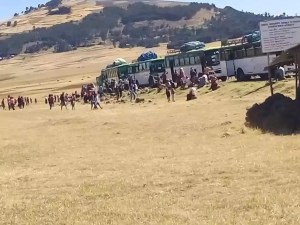When the war in Tigray broke out in November 2020 there were just under 100,000 Eritrean refugees living in four camps in Tigray. They had lived side by side with their Tigrayan neighbours, with help from the UNHCR. The generous hospitality they received from many of their neighbours was admirable. Eritreans also left the camps to live in the local area, or in Ethiopia’s cities.
But when Prime Minister Abiy Ahmed came to power and made peace with Eritrea’s President Isaias, the situation began to change. President Isaias loathed the refugees who had fled from his regime and distrusted those who lived in the camps in Tigray. Under pressure, Prime Minister Abiy agreed to close the camps or reduce the numbers in them. This was not fully implemented, but the writing was on the wall: the welcome Ethiopia had given Eritrean refugees was going cold.

When the war began the two northern camps were rapidly over-run by Eritrean forces. Eritrean refugees were brutally treated by them: forced to enlist or trucked back to Eritrea at gunpoint. Many fled to Ethiopian cities to escape this fate.
But as the war went on, and the atrocities inflicted on the people of Tigray by Eritrean forces became clear, some Tigrayans turned on the remaining Eritrean refugees living in their midst.
Stories emerged of attacks by armed groups on the Eritreans living in Tigray. Why this happened is not clear: perhaps Tigrayans thought that President Isaias had placed Eritrean agents among the refugees, who were then sending back information to the Eritrean government.
President Isaias has developed an extensive network of spies and agents inside Eritrea and abroad. They spy on every town and village in Eritrea. They inform on diasporic communities around the world. But this does not mean that every Eritrean is a spy - far from it.
One has to also accept that some Tigrayans - driven by grief and anger after the rape, mutilation and murder of family members - may have turned on the only Eritreans they could take it out on: the refugees.
The government of Tigray has a clear responsibility to protect the refugees in their midst, even in these extraordinarily difficult times. The information we have received about the fate of Eritreans in Tigray is worrying. So too is the plight of Eritreans living in Addis Ababa, who are being singled out by Ethiopian security forces and by Eritrean agents in the capital.
Below is some of the background information - carefully gathered and collated. It requires action by the governments of Ethiopia and of Tigray.
Eritrean refugees in Ethiopia
- In Adigrat, 500-600.
- In Shire, about 450.
- In Mekele, about 2700.
From the UNHCR Situation Report 6 September 2021
Relocation
While providing immediate support with limited access, UNHCR’s priority is to facilitate the relocation of refugees out of the conflict areas as soon as possible to continue to call for cessation of hostilities to be able to do so. In this regard, UNHCR is working urgently to construct a new camp, Alemwach, which will be able to host some 25,000 refugees from Mai Aini and Adi Harush camps. UNHCR and the Ethiopian Agency for Refugees and Returnees Affairs (ARRA) have also developed a relocation plan ready to be implemented. UNHCR also continues to be very concerned about the safety and well-being of thousands of refugees that are unreachable. For months, UNHCR has been working with ARRA to locate, identify and support the Eritrean refugees who were previously sheltered in the Northern Tigray refugee camps of Hitsats and Shimelba, but fled when those camps were destroyed in January 2021.
Addis Ababa
Since 4 August, UNHCR has started a documentation exercise for Eritrean refugees who self-relocated to Addis Ababa from the former Shimelba and Hitsats camps, at the Organisation for Women in Self Employment (WISE) office. The documentation exercise for Eritrean refugees, as of 31 August, issued new refugee IDs to 5,542 individuals / 4,441 households, and new proof of registration documents to 855 individuals/583 households. A total of 4,459 individuals have been assisted to open bank accounts to facilitate the transfer of cash assistance from UNHCR (and facilitate the reception of remittances from abroad).
አባሰንጋ ፈንግል፥ፈንቅል፥ የገደላቸውን ከብት፥በግና ዶሮ ሰብስበን ሰልፊ አብረን ተነስተን ይሄ ያንተ እነዚያ ከብቶች ደግሞ የአንበርብር በጎቹ ደግሞ የብርቅነሽ ናቸው ብለን ወያኔን ማሳጣት ነው፥፥አህያ አያስፈልገንም ስንት ሕፃንና መለኩሴ ሲጋ ድ ል : የነበረ ፋንፋናም ፋኖ ይበቃል ፥፥የአማራ ታክቲክ የሞተ ነው ዥልጦች ፈጣ ለባሽ ሁላላ
may the new year be a year of disaster to Amhara elites and their supporters like Deguma, henock alemayehu ,eritrean refugees proved to be spies of higdef pro almariam(dope) who drink katikala at starbucks with american katikala cups.